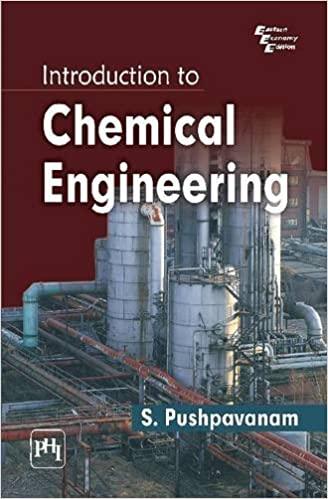Answered step by step
Verified Expert Solution
Question
1 Approved Answer
Write the code!! in a batch reactor, there is no flow into or out of the reactor, and thus those terms drop out. The accumulation
Write the code!!
in a batch reactor, there is no flow into or out of the reactor, and thus those terms
drop out. The accumulation term can be written as while the
generationconsumption term comes from the rate law for the reaction rx wh
is the chemical species. For this series reaction, the rate laws are as follows:
Plugging in the rate law for A into Eqn. written for gives
Plugging in the other rate laws will give the other material balances, resulting in a
system of three ordinary differential equations ODEs P would like you to use an
ODE solver to calculate the concentrations of A B and C as a function of time in the
reactor for At reactor startup, the concentration of in the reactor is
and no or is present.
P has requested a plot of concentration vs time that looks professional, with
legend, title, axis titles, and data for all three species plotted over an appropriate
length of time ie Make sure the concentrations are fully developed, but not sitting
constant for of the plot Finally, determine the maximum concentration of B over
the course of the reaction at this temperature Hint: numpy.maxarrayname For
extra credit, determine the time at which this maximum cb occurs and the ratio of
undesired byproduct to desired product that coincides with the maximum
Now that you have solved the system of ODEs for would like you to
consider and Compare the maximum ratio of c at these
consider
It is perfectly acceptable to do this by changing the temperature and running the
same program three more times. However, for extra credit, loop through the
temperature values using and array and a "for loop" or use the input function from
our first weeks to request the temperature from the command line.
All the material needed to solve these engineering problems was covered in lecture
and the homework. I promise it will go better if you rely on the class material instead
of "googling" how to do these steps. Remember to submit your final project as a
memo to P with: appropriate background, a description of the approaches
used for solving the problems, results reported clearty, both values with error
and graphs, a conclusion and recommendation, and Include your codes as an
appendix. I highly recommend you write separate codes for tasks and

Step by Step Solution
There are 3 Steps involved in it
Step: 1

Get Instant Access to Expert-Tailored Solutions
See step-by-step solutions with expert insights and AI powered tools for academic success
Step: 2

Step: 3

Ace Your Homework with AI
Get the answers you need in no time with our AI-driven, step-by-step assistance
Get Started


